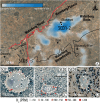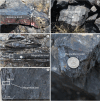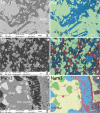A new continental hydrogen play in Damara Belt (Namibia)
- PMID: 38778079
- PMCID: PMC11111756
- DOI: 10.1038/s41598-024-62538-6
A new continental hydrogen play in Damara Belt (Namibia)
Abstract
Serpentinization is commonly presented as the main source of natural hydrogen (H2) in the continental domains. However, recent works in Australia and Brazil showed that Archean-Paleoproterozoic banded iron formations could be another natural source of H2 gas. Although the reaction that produces hydrogen is similar (Fe2+ oxidation-H2O reduction process), the iron content may be higher in banded iron formations than in mafic igneous lithologies, potentially generating H2 more efficiently. Here, we present structural evidence that reported H2 emissions from Waterberg Basin, Namibia are associated with underlying Neoproterozoic banded iron formations-the Chuos Formation. Magnetite, a known H2-generating mineral, is ubiquitous and accompanied by other suspected H2-generating minerals (biotite and siderite) in Chuos Formation. Magnetite occurs either as pervasive cm to dm continuous metamorphic laminations in foliation and fractures planes and/or diffusely disseminated in metachert and metacarbonate levels. From this, we infer that metamorphism does not negatively affect the Fe2+ content that is required to generate hydrogen. H2 seepages in Waterberg Basin suggest that an active H2-generating system may exist at depth and that the presence of potential traps and reservoirs is likely based on field observations.
© 2024. The Author(s).
Conflict of interest statement
The authors declare no competing interests.
Figures







References
-
- Prinzhofer A, Cissé CST, Diallo AB. Discovery of a large accumulation of natural hydrogen in Bourakebougou (Mali) Int. J. Hydrog. Energy. 2018;43(42):19315–19326. doi: 10.1016/j.ijhydene.2018.08.193. - DOI
-
- Klein F, Tarnas JD, Bach W. Abiotic sources of molecular hydrogen on Earth. Elem. Int. Mag. Miner. Geochem. Pet. 2020;16(1):19–24. doi: 10.2138/gselements.16.1.19. - DOI
-
- Zgonnik V. The occurrence and geoscience of natural hydrogen: A comprehensive review. Earth Sci. Rev. 2020;203:103140. doi: 10.1016/j.earscirev.2020.103140. - DOI
-
- Lévy D, Roche V, Pasquet G, Combaudon V, Geymond U, Loiseau K, Moretti I. Natural H2 exploration: Tools and workflows to characterize a play. STET. 2023 doi: 10.2516/stet/2023021. - DOI
LinkOut - more resources
Full Text Sources

